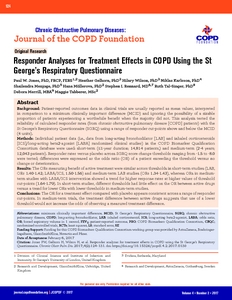Jones, PW; Gelhorn, H; Wilson, H; Karlsson, N; Menjoge, S; Müllerova, H; Rennard, SI; Tal-Singer, R; Merrill, D; Tabberer, M
(2017)
Responder Analyses for Treatment Effects in COPD Using the St George's Respiratory Questionnaire.
Chronic Obstr Pulm Dis, 4 (2).
pp. 124-131.
ISSN 2372-952X
https://doi.org/10.15326/jcopdf.4.2.2017.0130
SGUL Authors: Jones, Paul Wyatt
![[img]](https://openaccess.sgul.ac.uk/109131/1.hassmallThumbnailVersion/JCOPDF-2017-0130-Jones.pdf)  Preview |
|
PDF
Published Version
Available under License ["licenses_description_publisher" not defined].
Download (2MB)
| Preview
|
Abstract
Background: Patient-reported outcomes data in clinical trials are usually reported as mean values, interpreted in comparison to a minimum clinically important difference (MCID) and ignoring the possibility of a sizable proportion of patients experiencing a worthwhile benefit when the majority did not. This analysis tested the reliability of calculated responder rates (from chronic obstructive pulmonary disease [COPD] patients) with the St George's Respiratory Questionnaire (SGRQ) using a range of responder cut-points above and below the MCID (4 units). Methods: Individual patient data (i.e., data from long-acting bronchodilator [LAB] and inhaled corticosteroids [ICS]/long-acting beta2-agonist [LABA] randomized clinical studies) in the COPD Biomarker Qualification Consortium database were used: short-term (≤1-year duration; 14,814 patients,) and medium-term (2-4 years; 12,043 patients). Responder rates versus placebo across SGRQ score change thresholds ranging from -1.5 to -8.0 were tested; differences were expressed as the odds ratio (OR) of a patient exceeding the threshold versus no change or deterioration. Results: The ORs measuring benefit of active treatment were similar across thresholds in short-term studies (LAB, ORs 1.40-1.42; LABA/ICS, 1.50-1.56) and medium-term LAB studies (ORs 1.34-1.43), whereas ORs in medium-term studies with LABA/ICS intervention showed a trend for higher response rates at higher values of threshold cut-points (1.64-1.79). In short-term studies, different thresholds had little effect on the OR between active drugs versus a trend for lower ORs with lower thresholds in medium-term studies. Conclusions: The OR for a treatment effect compared with placebo appears consistent across a range of responder cut-points. In medium-term trials, the treatment difference between active drugs suggests that use of a lower threshold would not increase the odds of observing a measured treatment difference.
Statistics
Item downloaded times since 14 Sep 2017.
Actions (login required)
 |
Edit Item |



